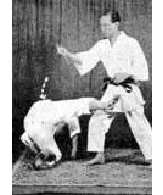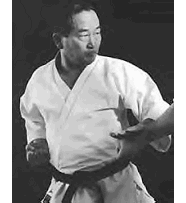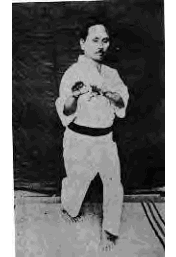|
Sho-go
 SHO-GO is the teaching title-system set up by the Dai-Nippon Budoku-kai (greater Japan Budo Encouragement Federation established in 1895 in Kyoto). It is consist of three ranks, Renshi, Kyoshi and Hanshi (Highest).The sho-go awarded by the I.S.K.S will consist of the three similar ranks and are therefore classical ranks/titles similar to Samurai titles given under the auspices of Japan's Imperial Family during feudal times. The award of sho-go are based on each individual’s knowledge, teaching ability and the outstanding development of character through the study of the martial arts. Therefore it is important to realise that in the modern approach to martial arts, these titles/ranks are much more difficult to achieve than the conventional Dan grades and are not automatically assigned with rank or seniority. The holder of these titles must also have made significant contributions to the martial arts community at large. SHO-GO is the teaching title-system set up by the Dai-Nippon Budoku-kai (greater Japan Budo Encouragement Federation established in 1895 in Kyoto). It is consist of three ranks, Renshi, Kyoshi and Hanshi (Highest).The sho-go awarded by the I.S.K.S will consist of the three similar ranks and are therefore classical ranks/titles similar to Samurai titles given under the auspices of Japan's Imperial Family during feudal times. The award of sho-go are based on each individual’s knowledge, teaching ability and the outstanding development of character through the study of the martial arts. Therefore it is important to realise that in the modern approach to martial arts, these titles/ranks are much more difficult to achieve than the conventional Dan grades and are not automatically assigned with rank or seniority. The holder of these titles must also have made significant contributions to the martial arts community at large.
The title/sho-go may or may not be given to a Fellow on application, or may be awarded after the fellow has been in fellowship for some time. The three awarded by the ISKS as previously stated are: Renshi (which may be awarded to 6th Dan and above over 40 years old) Kyoshi (which may be awarded to 7th Dan and above over 50 years old) and Hanshi (which may be awarded to 8th Dan and above over 60 years old). This also means that any grade from 6th Dan and above may only receive an award of Renshi or none at all. Therefore sho-go are not automatically given to successful fellowship applicants of the ISKS.
The Technical Committee reserves the right to award individuals sho-go without asking for referees (see below), based on an individual being of international renown. This however will be agreed unanimously by the Technical committee on acceptance of their initial application. Alternatively if the individual is currently an ISKS fellow and is well known to them, then the Technical Committee may once again wish to waver the need for referees. In this instance the Technical Committee by virtue of the award, would be acting as the referees themselves.
The meaning of the sho-go
 The character "Ren" means "polished, tempered" and "shi" means "person". Thus Renshi indicates a "polished instructor" or expert. Renshi may be awarded to the modern rank of 6th Dan or above in the ISKS interestingly the title of Renshi is of Japanese origin and is not used in Okinawa. As the I.S.K.S has Japanese roots Renshi, Kyoshi and Hanshi are awarded. The character "Ren" means "polished, tempered" and "shi" means "person". Thus Renshi indicates a "polished instructor" or expert. Renshi may be awarded to the modern rank of 6th Dan or above in the ISKS interestingly the title of Renshi is of Japanese origin and is not used in Okinawa. As the I.S.K.S has Japanese roots Renshi, Kyoshi and Hanshi are awarded.
The "Kyo" in Kyoshi means "professor" or "philosophy". Therefore, Kyoshi equals a "professor" capable of teaching the philosophy of the martial arts. Kyoshi may be awarded to the modern rank of 7th Dan and above in the ISKS.
The "Han" in Hanshi means "example, model" and indicates "a teacher that can serve as an ideal model for others", or a “senior master”. Hanshi may be awarded to the modern day rank of 8th and above in the ISKS.
Awarding a sho-go:
RENSHI
Any ISKS fellow of 6th Dan or above exceeding the age of 40 years old can apply for the Renshi title if not previously awarded by the Technical Committee (T.C.).
The applicant for sho-go must put in writing, supported and refereed by two ISKS fellows explaining why s/he merits this title. The ISKS T.C. may request additional information or cause a background investigation to be conducted. By majority vote the I.S.K.S may confer the title of Renshi to the applicant
KYOSHI
Any ISKS fellow of 7th Dan or above, 5 years after their Renshi registration, and exceeding the age of 50 years old can apply for the Kyoshi title if not previously awarded by the Technical Committee. If the applicant does not hold a previous sho-go, they may apply directly for one which their age and grade merits. It is therefore normal that the applicant would hold the sho-go of Renshi but this is not a necessary requirement.
The applicant for sho-go must put in writing, explaining why s/he merits this title. The application must be supported and refereed by two ISKS fellows who must also write to the ISKS T.C. describing in detail, the candidate's character and behaviours which justify the Kyoshi title. After deliberations (and any appropriate additional investigations) the candidate may be declared Kyoshi if the I.S.K.S agrees by a 2/3rds majority. The ISKS T.C. may request additional information or cause a background investigation to be conducted.
HANSHI
 This is a very special title representing the highest levels of martial arts, political involvement as a practitioner, be seen as an innovator, a teacher of and show personal growth an in depth understanding of the style of Shotokan–ryu. Any ISKS fellow of 8th Dan or above, 10 years after their Kyoshi registration and exceeding the age of 60 years old can apply for the Hanshi title if not previously awarded by the Technical Committee. It is normal that the applicant would hold the sho-go of Kyoshi previously but not necessary. This is a very special title representing the highest levels of martial arts, political involvement as a practitioner, be seen as an innovator, a teacher of and show personal growth an in depth understanding of the style of Shotokan–ryu. Any ISKS fellow of 8th Dan or above, 10 years after their Kyoshi registration and exceeding the age of 60 years old can apply for the Hanshi title if not previously awarded by the Technical Committee. It is normal that the applicant would hold the sho-go of Kyoshi previously but not necessary.
The applicant for sho-go must put in writing, explaining why s/he merits this title. The application must be supported and refereed by four ISKS fellows who must also write letters to the ISKS T.C. describing in detail, the candidate's character and behaviours which justify the Hanshi title. After deliberations (and any appropriate additional investigations) the candidate may be declared Hanshi if the I.S.K.S unanimously agrees. The ISKS T.C. may request additional information or cause a background investigation to be conducted.
Belts other than the black belt used by those who have been awarded a sho-go in accordance with international Shotokan protocol and tradition, will be disallowed in the ISKS: (6th and 7th Dans Renshi/Kyoshi in some styles wear a red & white belt, 8th, 9th and 10th Dans Kyoshi/Hanshi wear a red belt), The black belt is the only obi to be used by ISKS fellows of any rank or title.
Use of the sho-go as a suffix, is allowed, although it is not protocol nor traditional in the Shotokan system to have any Dan grade or sho-go or any other title such as 'Saiko-shihan' written on the obi.
|